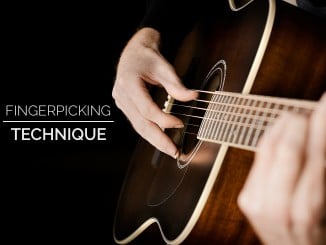
Objectives
- Learn all the intervals.
- Learn the fretboard patterns for the intervals.
- Learn both ways to play intervals.
What Are Intervals?
An interval is the pitch difference between two notes. Pitch differences can be viewed in different ways.
- Note Difference: C to D
- Step Difference: C to D is a whole step. C to D-Flat is a half step.
- Fret Difference: C to D is 2 frets in distance. (Ex: Second String – 1st fret is C, 3rd fret is D)
- Interval: C to D is Major Second interval.
In music theory, interval names are the formal way to describe pitch differences. They are universal across instruments and the music community. Understanding intervals will help you understand chords, scales, improvisation, and other advanced theory topics.
Interval Chart
This chart sums up all of the intervals by giving their name and pitch difference. The audio example plays both types of intervals: melodic and harmonic. Melodic intervals are played sequentially, one note at a time. Harmonic intervals are played simultaneously, at the same time.
| Interval Name | Abbreviation | Step Distance | Fret Distance |
Audio (Played Melodically then Harmonically) |
| Unison | U | None (Same note) |
0 |
|
| Minor Second | m2 | Half Step | 1 | |
| Major Second | M2 | Whole Step | 2 | |
| Minor Third | m3 | Whole Step + Half Step | 3 | |
| Major Third | M3 | 2 Whole Step | 4 | |
| Perfect Fourth | P4 | 2 Whole Steps + Half Step | 5 | |
| Augmented Fourth Diminished Fifth Tritone |
A4 D5 TT |
3 Whole Steps | 6 | |
| Perfect Fifth | P5 | 3 Whole Steps + Half Step | 7 | |
| Minor Sixth | m6 | 4 Whole Steps | 8 | |
| Major Sixth | M6 | 4 Whole Steps + Half Step | 9 | |
| Minor Seventh | m7 | 5 Whole Steps | 10 | |
| Major Seventh | M7 | 5 Whole Steps + Half Step | 11 | |
| Octave | Oct | 6 Whole Steps (Same Note Name) |
12 |
Interval Numbering
Intervals are numbered as unison, seconds, thirds, fourths, fifths, sixths, sevenths, or octaves. This number can be determined by the number of notes that the two notes span.
Example: C to F is a fourth because it spans C, D, E, and F.
In music theory, it is important to remember that the number is based on the difference in the note names, not the pitch difference. This is why Augmented Fourths and Diminished Fifths are the same pitch difference, but are different names. Example: C to F-Sharp (Augmented Fourth) and C to G-Flat (Diminished Fifth) is the same pitch distance (3 whole steps), but they have different interval names because of the note names.
Intervals on the Staff
Here is an example of the intervals relative to middle C. Take note of the note name differences.

Intervals on the Fretboard
The diagram below shows the intervals from the first fret.
Examples
- First fret to the second fret is a minor second (1 frets up).
- First fret to the fifth fret is a major third (4 frets up).
- First fret to the eleventh fret is a minor seventh (10 frets up).

Songs to Remember the Intervals






Hi,
In the intervals chart (the table), Augmented Fourth and Diminished Fifth are mentioned as A4, D4. It should be D5. It’s again correctly mentioned in “Intervals on the Fretboard”, but just a typo in the table part.
Cheers.
Thank you for your comment. I have fixed the typo. As a thank you, I emailed you a special offer on my books.
thank you for this
How to name the interval f# – c in key a min?
Thanks for the question. F# to C is a diminished fifth, otherwise known as a the tritone (short for 3 tones or 3 whole steps). It starts with F#, spans 5 letters (F, G, A, B, C), and is three whole steps.
Very neat with examples. Thanks for this lesson, had been searching for intervals.
This is great. Gives a basic knowledge to people like me who are a little behind on theory.
Very informative and helpful
Thank you for the kind words! I’m glad the lesson helped.
I cannot thank you enough for sharing your knowledge with us. As a self taught guitarist its important to find good quality lessons and insight when it comes to music theory. You made me a better artist.
Thank you for your kind words! I’m glad I could help you be a better artist.
You’re such a great teacher. I really appreciate this lesson.
Thank you for the kind words.